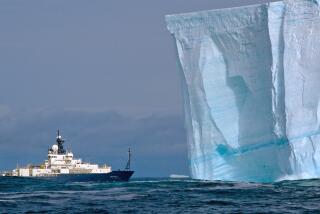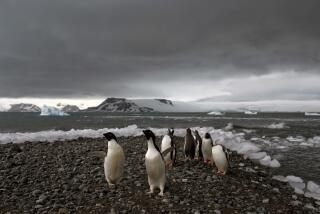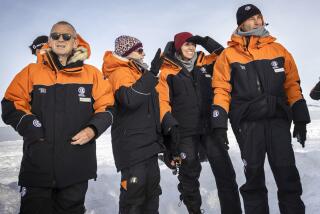Seeing Antarctica Through a Child’s Eyes
- Share via
The children had never spoken to the press before, let alone on the complicated issues concerning the global environment. But as the six boys and girls listened to the journalists’ questions at a New York news conference in late January, their faces showed their thoughtfulness.
They had just returned from an expedition to Antarctica with my father, Jacques-Yves Cousteau, and a team of divers. Each child was chosen to represent a different continent: Jeronimo Brunner of Chile (South America), Cory Gillmer of the United States (North America), Oko Joseph Shio of Tanzania (Africa), Kelly Matheson of Australia, Fumiko Matsumoto of Japan (Asia), and Elise Otzenberger of France (Europe).
None of the children, all 11 or 12 years of age, had ever made a journey quite like the Antarctic expedition. Having reached Punta Arenas in the Strait of Magellan on Jan. 3, 1990, they boarded a specially equipped vessel we had chartered and set sail. I was to join them later by plane, but gale force storms--exactly the sort that are common yet unpredictable in the Antarctic region--kept me grounded in Chile.
Under the Antarctica Treaty signed in 1959, nations claiming territory in Antarctica agreed to hold their claims in abeyance in favor of reserving this vast white land for peaceful and scientific purposes.
We wanted to show the children a world not only free of pollution, but also free of dispute. We also wanted to show them what is at stake if mining and offshore oil exploitation were to be permitted in such a remote, fragile environment.
While adults might say children of such tender age could not understand the subtleties and overall meaning of the trip, their later reflections demonstrated just the opposite.
“Of course the penguins were not afraid of us,” Cory Gillmer said in response to one journalist’s question. “They had never seen humans before.”
The splendor of Antarctic summer--blindingly white towers and blankets of ice under a dome of blue sky that can suddenly turn metal-gray--deeply impressed them. And not only the sights, but the sounds: “All night long, we could hear the ice cracking and falling like thunder in the water,” Kelly Matheson recalled. “It was lovely,” she added softly.
The expedition members saw whales and elephant seals breaking the surface of frigid seas, soaring albatrosses, thousands of Adelie penguins with young just born. The children also saw penguins clustered on a patch of snow tossed on an otherwise brown and rubbly hill, taking the heat reflected from the ice. They easily understood that it is precisely this reflective property of ice that is important to preserve. If the Antarctic icecap--which contains 90% of the world’s ice--ever melts (a likely result of increased human activities on the continent), not only will sea levels rise, but heat that would otherwise be reflected will be absorbed, adding to the problems of the greenhouse effect and global warming.
The expedition traveled by sea from a Chilean scientific base on the Antarctic peninsula to scientific stations operated by the governments of Poland, Brazil and the Soviet Union. At the U. S. base at Palmer Station, they came face to face with the first real blemish on Antarctica--an oil spill caused by the wreck of an Argentine supply ship in early 1989. The now-capsized ship is thus far unsalvaged and is very likely unsalvageable. From a distance, the narrow bit of metal that remains above the surface could be mistaken for the very rocks on which the vessel ran aground.
Underwater, the ship lies cracked like an eggshell, still holding barrels of oil. The ghostly hull itself has become covered with strands of brown algae, nourished in the cold water by the seeping oil. The wreck, of course, is but a tiny example of what could happen in Antarctica if offshore oil exploration or industrialization were to go forward.
The children also saw a skeleton of a blue whale reconstructed by the Calypso crew in 1972, still almost as perfectly intact as when it was first put together. Its excellent condition attests to the fact that biodegradation is extremely slow in Antarctica--meaning that it would take decades for crude oil to dissipate.
But Elise Otzenberger had another interpretation: “It is in good shape because not too many people have been there, and those who were had too much respect to move the bones around, to destroy the whale or the environment there.”
More to Read
Sign up for Essential California
The most important California stories and recommendations in your inbox every morning.
You may occasionally receive promotional content from the Los Angeles Times.










